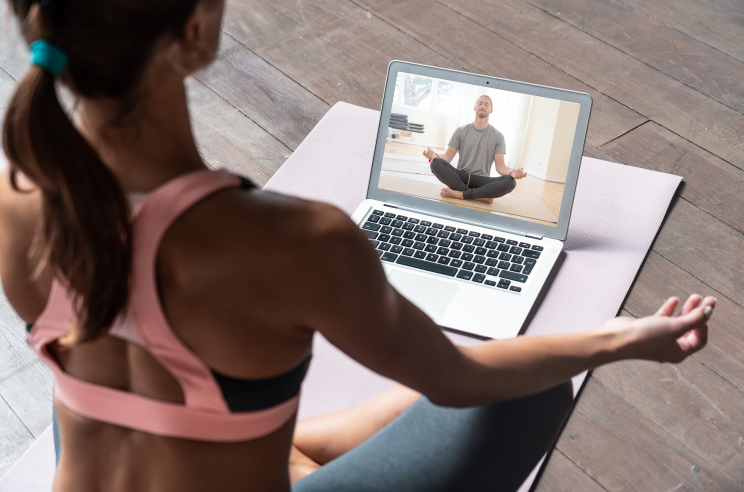Digital Fitness: How Live Streaming Will Shape the Future of Exercise

For some (i.e., me), COVID-19 lockdowns have doubled as a convenient excuse for not meeting the recommended workout guidelines. Between gym closures and face mask mandates, 2020 simply hasn’t been the year for toning and sculpting your way to the perfect beach body.
But for the more motivated among us — those dead set on combating the ‘quarantine 15’ — the burgeoning digital fitness market has provided tools to keep moving. Numerous fitness services now integrate live video streaming to recreate in-person experiences, effectively teleporting exercise regimens from fitness studios to our living rooms and basements.
This fusion of technology into the industry yields increased convenience, cost-savings, and more advanced capabilities. Digital fitness now encompasses everything from smart exercise bikes to local yoga classes broadcasted on Zoom. And when it comes to the future of exercise, we’ve only scratched the surface of what live streaming can deliver.
Pedaling Toward the Future With Peloton
At the end of 2019, Peloton was making headlines for all of the wrong reasons. Their controversial holiday commercial caught flack for promoting sexism and problematic body ideals. Officially named “The Gift That Gives Back,” the ad gifted Peloton a ten-percent drop in their stock and nearly one billion dollars in losses.
But, alas, that was back in December. The World Health Organization (WHO) hadn’t yet identified COVID-19. And nobody could have predicted the Black Mirror-esque year that would follow.
Many aspects of the Peloton commercial would have certainly resonated better with today’s socially distanced audience. For one thing, there’d no longer be any scrutiny of the fact that the ad’s protagonist embarked on her year-long fitness journey in complete isolation, while documenting it on her smartphone.
In one article from December of last year that described the commercial as a dystopian nightmare, the author remarked, “It is unclear if this woman has friends beyond her partner, her child, and her Peloton.”
From where we stand now, this lack of contact with the outside world is all too relatable. And the excitement that the woman in the commercial feels when her instructor says her name over the live video stream honestly makes a lot of sense.
Why? Because in 2020, connected fitness has evolved from a niche way to stay in shape to a mainstream health necessity. Beyond just physical benefits, the integration of wellness and tech now serves as a practical and prevalent route to social engagement — keeping users connected in every sense of the word. That’s why Peloton’s stock continues to climb, and tech giants ranging from Apple to Amazon are trying to get in on the action.
Connected Fitness Equipment and Physical Interactive Media
Peloton first disrupted the health industry in 2012 by selling both a product and a service tied into one. The product, a stationary bike with a 22-inch touchscreen, allows users to stream live and on-demand exercise classes via a monthly subscription service. The genius of this strategy is that Peloton manages to secure big, one-time purchases and small, subscription-based revenue in one fell swoop.
Peloton essentially created a new industry, dubbed physical interactive media. Users live stream cycling classes, benefiting from both the community of a group exercise class and the flexibility of an at-home workout.
NordicTrack was quick to follow suit with its own line of smart home gym equipment and the iFit app. There’s also the Mirror, a full-length mirror-slash-LCD screen streaming a range of exercise classes, as well as real-time personal training sessions with specialized instructors.

More recently, Amazon appeared to be entering the home exercise market, and Apple announced plans to expand into the virtual fitness space by offering online aerobics, yoga, and weight classes.
Wearable Devices and the Internet of Things (IoT)
For almost any organization in the fitness industry, a logical step toward staying afloat involves combining products and services into hybridized solutions. Even exercise activity trackers like Fitbit have added video streaming capabilities to their devices, allowing wearers to monitor their movement and stream workouts via the same gadget.

The global wearable devices market is expected to reach $62.82 billion by 2025.*
But IoT fitness doesn’t stop there. Video conferencing technology now allows users to join virtual workout environments from their smartwatches, and even dumbbells have gone digital.
In the mad dash to build out at-home gyms at the height of the pandemic, consumers faced a shortage of gym equipment earlier this year. I struggled to procure any hand weights over multiple trips to Wall-Mart — a purchase that I was reluctant to make online because shipping prices are dictated by, well, weight. Little did I know that much more compact alternatives were out there, which could be connected to an interactive video streaming app to deliver a more robust solution.
Omnichannel Fitness and the Next Normal
Whereas Gold’s Gym and 24 Hour Fitness have filed for bankruptcy this year, many digital fitness products and services have struggled to keep up with demand.
So are gyms officially dead? No way. But most gym-goers have become accustomed to the immersive experiences and always-on flexibility that technologies like live video streaming deliver.
Sadie Lincoln, CEO and co-founder of Barre3, explains:
“This is the new age, and an omnichannel approach to fitness is here to stay. Anyone with a brick and mortar is looking at how to leverage both the in-person and online program as an ecosystem. Nothing can replace being in person — with that beat and the music and being with your instructor and fighting loneliness together — I don’t think that’s going to go away, but I think it’s going to be augmented with digital in an important, powerful way.”
Working out is also often about more than just exercise. Gyms have long served as social hubs and therapeutic outlets. Today, online communities help extend these benefits beyond the physical location, allowing users to maintain momentum via live streamed classes.
For this reason, the future of fitness is omnichannel. Brick-and-mortal fitness clubs will need to create seamless experiences for members that merge the physical and digital even after the pandemic is finally under control.
For in-studio classes and at-home products, video streaming technology will help drive the industry forward. Immersive 3D experiences using virtual reality (VR) promise to reinvent the gym experience, and mobile technologies will play an essential role in keeping consumers connected 24/7.
The COVID-19 outbreak has demonstrated just how essential interactive video technologies are to business continuity. And it will continue to influence consumer behaviors for many years to come.




